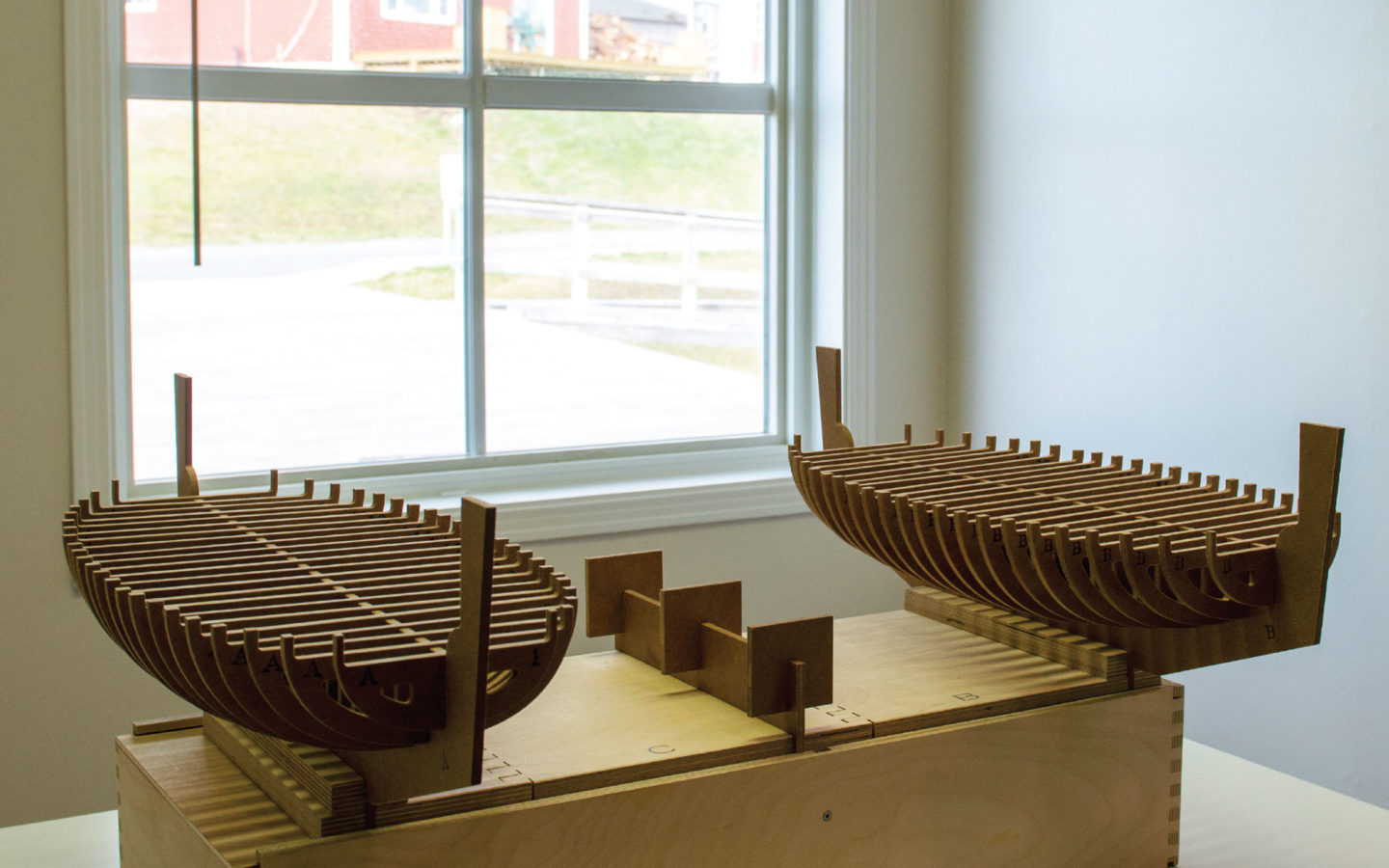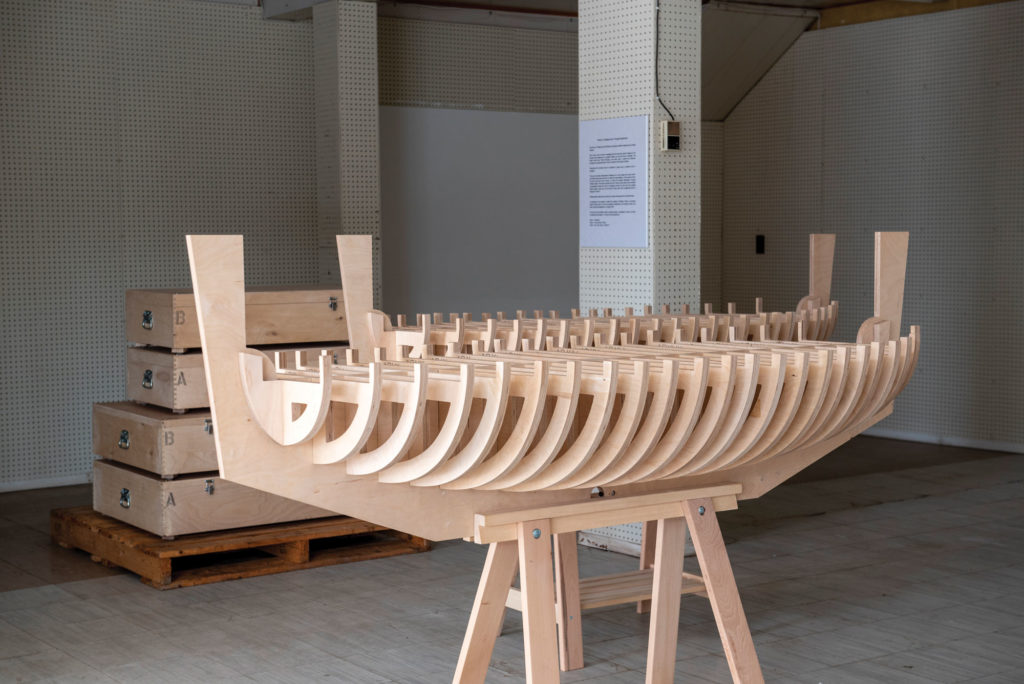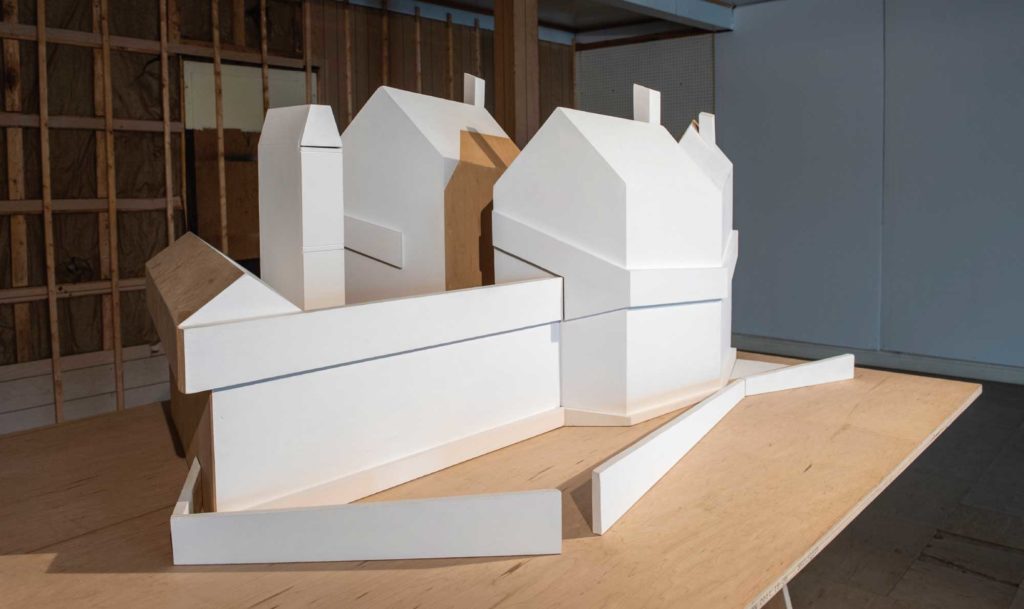Ian Carr-Harris + Yvonne Lammerich
NÉ À Victoria, CB | NÉ À Victoria, CB
HABITE À Rednersville, ON | HABITE À Rednersville, ON

NÉ À Victoria, CB | NÉ À Victoria, CB
HABITE À Rednersville, ON | HABITE À Rednersville, ON
Theoris: a paradox, A Game 2018
Sculpture
Site 7 — Ye Matthew Legacy Interpretation Centre, Bonavista
Theoris: a paradox 2018
Sculpture
Abitation 1608 2008
Sculpture
Site 14 — Salt Fish Plant, Catalina
Yvonne Lammerich et Ian Carr-Harris ont façonné des modèles en bois de structures iconiques qui remettent en question notre perception de l’histoire, du récit et de l’identité. Ils reproduisent Theoris, un navire athénien légendaire, en plusieurs exemplaires qui rappellent les navires vikings qui ont débarqué sur les côtes de Terre-Neuve il y a plus de mille ans. Les caisses d’expédition et les supports IKEA exposés avec les maquettes de navires permettent de les assembler et de les transporter facilement. Présentés près d’une réplique grandeur nature du Matthew, le navire de l’explorateur John Cabot, les modèles de Carr-Harris contestent la notion d’« original ». Construits en bois, ces navires anciens ont nécessité tant de réparations qu’il ne leur reste plus un seul morceau d’origine. D’où la grande question : le Theoris est-il toujours le même vaisseau ? Les répliques des modèles de Carr-Harris semblent conserver leur aura malgré leur reproductibilité mécanique. L’identité est-elle liée à l’origine ou sculptée au fil du temps par les histoires qui la façonnent ?
Dans la salle voisine, Abitation 1608 d’Yvonne Lammerich est un modèle en trois dimensions du fort de Samuel de Champlain, à Québec. Réalisé à partir d’un dessin historique, Abitation confronte la malléabilité de l’histoire au fil du temps. Abitation reproduit une structure coloniale dans une ère postcoloniale. Champlain n’est pas venu en conquérant, mais en commerçant désireux de favoriser le rapprochement avec les cultures autochtones. Il a appris la langue de ces peuples et leurs techniques de survie. Abitation 1608 s’inspire d’une image qui intègre les dimensions de la cartographie et de la perspective pour faire le pont entre deux formes de savoirs, comme reconnaissance de l’emplacement du poste de traite européen sur le site du village iroquois de Stadacona. Ces expositions sont installées dans une ancienne usine de traitement du poisson, un espace industriel brut qui conserve des traces de sa vocation première. Ensemble, les œuvres d’art et le site évoquent les couches complexes de la colonisation, de l’exploitation des ressources et de l’interprétation historique. CB

En haut : Ian Carr-Harris, Theoris: a paradox, A Game 2018. Contreplaqué, bois, panneau dur, ferrures, dimensions variables.
1 : Ian Carr-Harris, Theoris: a paradox 2018. Contreplaqué, bois, panneau dur, ferrures, dimensions variables.
2 : Yvonne Lammerich, Abitation 1608 2008. Peinture sur bois, dimensions variables.


BORN Victoria, BC | BORN Victoria, BC
LIVES Rednersville, ON | LIVES Rednersville, ON
Theoris: a paradox, A Game 2018
Sculpture
Site 7 — Ye Matthew Legacy Interpretation Centre, Bonavista
Theoris: a paradox 2018
Sculpture
Abitation 1608 2008
Sculpture
Site 14 — Salt Fish Plant, Catalina
Lammerich and Carr-Harris have meticulously crafted wooden models of iconic structures that challenge our perception of history, narrative and identity. Theoris, a legendary Athenian ship, is replicated by Carr-Harris in multiples that recall the Viking ships that landed on the shores of Newfoundland over a thousand years ago. Shipping crates and IKEA stands exhibited with the ship models convey their easy assemblage and portability. Displayed near an actual-size replica of the Matthew, John Cabot’s ship of discovery, Carr-Harris’ models challenge the notion of “original”. Such ancient wooden ships were in constant need of repair, with new wood continually replacing the old rotten wood. Over time not a single piece of original fabric remained, begging the question: Is Theoris still the original ship? Carr-Harris’ replica models appear to retain their aura despite their mechanical reproducibility. Is identity, then, tied to origin or formed over time through the stories that shape it.
In the next room, Abitation 1608 by Yvonne Lammerich is a three-dimensional model of Samuel de Champlain’s trading fort at Quebec. Realized from an historical drawing in skewed perspective, Abitation confronts the malleability of history through time. Collapsing perspective, Abitation replicates a Colonial structure in a post-colonial era. Champlain came more as trader than conqueror, eager to open contact with the indigenous cultures he encountered, and learn the native languages and means of survival. Abitation 1608 was inspired by an image that folds together the cartographic and the perspectival dimensions, bridging two types of knowledge as an acknowledgement of the location of the European trading fort at the site of the Iroquois village of Stadacona. These exhibitions are installed in a former salt fish plant, a raw industrial space that retains traces of its former use. Together, artworks and site imply the complicated layers of colonization, resource extraction and historical interpretation. CB

Top : Ian Carr-Harris, Theoris: a paradox, A Game 2018. Plywood, wood, hardboard, metal hardware, dimensions variable.
1 : Ian Carr-Harris, Theoris: a paradox 2018. Plywood, wood, hardboard, metal hardware, dimensions variable.
2 : Yvonne Lammerich, Abitation 1608 2008. Paint on wood, dimensions variable.
